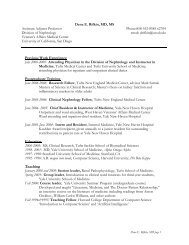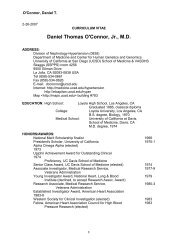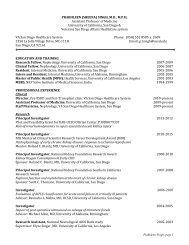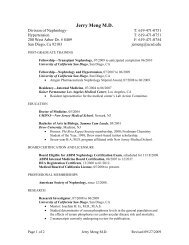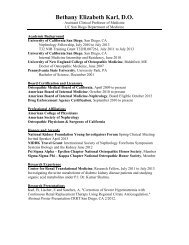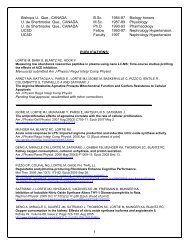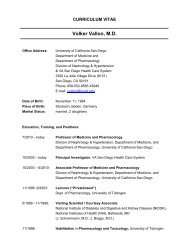BIOGRAPHICAL SKETCH Laurent JC. TAUPENOT, Ph.D. ltaupenot ...
BIOGRAPHICAL SKETCH Laurent JC. TAUPENOT, Ph.D. ltaupenot ...
BIOGRAPHICAL SKETCH Laurent JC. TAUPENOT, Ph.D. ltaupenot ...
You also want an ePaper? Increase the reach of your titles
YUMPU automatically turns print PDFs into web optimized ePapers that Google loves.
<strong>BIOGRAPHICAL</strong> <strong>SKETCH</strong><br />
Provide the following information for the key personnel and other significant contributors in the order listed on Form Page 2.<br />
Follow this format for each person. DO NOT EXCEED FOUR PAGES.<br />
NAME<br />
<strong>Laurent</strong> <strong>JC</strong>. <strong>TAUPENOT</strong>, <strong>Ph</strong>.D.<br />
eRA COMMONS USER NAME<br />
<strong>ltaupenot</strong><br />
POSITION TITLE<br />
Associate Professor<br />
EDUCATION/TRAINING (Begin with baccalaureate or other initial professional education, such as nursing, and include postdoctoral training.)<br />
DEGREE<br />
INSTITUTION AND LOCATION<br />
YEAR(s) FIELD OF STUDY<br />
(if applicable)<br />
University of Burgundy, Dijon, France A.Sc. 1987 Chemical & Natural Sciences<br />
University of Burgundy, Dijon, France B.Sc. 1988 Cell Biology & <strong>Ph</strong>ysiology<br />
University of Burgundy, Dijon, France M.Sc. 1989 <strong>Ph</strong>ysiology<br />
Univ. Louis Pasteur, Strasbourg, France Post.Grad (DEA) 1990 Molecular & Cellular Biology<br />
Univ. Louis Pasteur, Strasbourg, France <strong>Ph</strong>.D 1995 Molecular & Cellular Neurobiology<br />
University of California at San Diego Fellow 1995-01 Chromaffin Cell Biology<br />
A. Positions and honors<br />
Position and Employment:<br />
1989. Undergraduate student. Dept. of <strong>Ph</strong>ysiology, University Louis Pasteur, Strasbourg, France.<br />
1989-1990. Graduate student. Laboratory of Ontogenic Neurobiology-CNRS UPR 417, University Louis Pasteur,<br />
Strasbourg, France.<br />
1991-1995. <strong>Ph</strong>.D. Student. Institute of Biology of Cellular Communication-INSERM-U338, University Louis Pasteur,<br />
Strasbourg, France.<br />
1993. Visiting Research Fellow. Dept. of <strong>Ph</strong>ysiology, University of Bergen, Norway.<br />
1995-2001. Postdoctoral Fellow., Dept of Medicine, UCSD and VA-Medical Center, La Jolla, CA.<br />
1995-2001. Postgraduate Researcher. Dept of Medicine, UCSD and VA-Medical Center, La Jolla, CA.<br />
1999-2001. Project Scientist, Veteran Medical Research Foundation, San Diego, CA.<br />
1995-present. Research Biologist. VA San Diego Health Care System, San Diego, CA.<br />
2001-2003. Assistant Research Biochemist (Faculty rank), Dept of Medicine, UCSD, La Jolla, CA.<br />
2003-2008. Assistant Professor of Medicine, Dept of Medicine, UCSD, La Jolla, CA.<br />
2008-present. Associate Professor of Medicine, Dept of Medicine, UCSD, La Jolla, CA<br />
Other experience and Professional activities.<br />
Member: The American Society for Cell Biology, The National Kidney Foundation. The Moores UCSD Cancer Center-<br />
Cancer Biology Program, The Catecholamine Club.<br />
Reviewer for Journals: J Clin Invest (1999, 2003), Mol <strong>Ph</strong>armacol (2000, 2001), Neuroscience lett. (2002), Can J <strong>Ph</strong>ysiol<br />
<strong>Ph</strong>armacol (2002), FASEB (2002, 2008), Exp Neurol (2003), Mol Brain Res (2003), Neurosignals (2004), Regul Pept<br />
(2004-2006), Curr Med Chem - Immunology, Endocrine & Metabolic Agents (2004), Trends Biochem Sci (2004), FEBS<br />
Letters (2005, 2005, 2005, 2006, 2007), <strong>Ph</strong>ysiol Genomics (2006), Dev Comp Immunol (2006), Arterioscler Thromb Vasc<br />
Biol (2006), J Biol Chem (2007), AJP: Heart and Circulatory <strong>Ph</strong>ysiology (2007), Biochemistry (2007), J Neurochem<br />
(2008), Annals Medicine (2008), J Neurosci (2008), Mol Cell Biol (2008). Grant Reviewer. Ad hoc reviewer National<br />
Medical Research Council, Singapore (2004-2005), Ad hoc reviewer AIRC Italian Association for Cancer Research<br />
(2005), Ad hoc reviewer, Netherlands Organisation for Scientific Research (NWO Dutch Research council), 2006. Ad hoc<br />
NIH/CSR study section member: Synapses, Cytoskeleton and Trafficking (SYN) (06/2005, 02/2006, 06/2008) and<br />
Molecular and Cellular Biology of Neurodegeneration (MCBND) (06/2008)<br />
Honors and Awards: Scholarship award, French Ministry of Education and Research (1990). Master (1989), Bachelor<br />
(1988) and Associate (1987) degrees received cum laude. Predoctoral Fellowship Award, French Direction des<br />
Recherches Etudes et Techniques (DRET)/ Centre National de la Recherche Scientifique (CNRS) (1991). Doctoral<br />
degree received summa cum laude with the congratulations of the Board of Examiners (1995). Postdoctoral Fellowship<br />
Award, The American Heart Association (1996, declined, to accept NKF award). Postdoctoral Fellowship Award, The<br />
National Kidney Foundation (1996). Young Investigator Award, 9th International Symposium on Chromaffin Cell Biology,<br />
Sapporo, Japan (1997). Research Scientist Development Award (1K01DK59628), NIDDK (2001). Postdoctoral Fellowship<br />
Award, The National Kidney Foundation (1998). MERF scholar, Medicine Education and Research Foundation, San<br />
Diego (2003). Research Scientist Development Award (2K01DK59628), NIDDK (2004). Research Project Grant R01<br />
DK067969-01A1, NIDDK (2005), American Heart Association Grant-in-Aid (0855181F, 2008-10)<br />
Conference Chair: Session Chair, 11 th International Symposium on Chromaffin Cell Biology (ISCCB), San Diego, CA<br />
(2001. Session Chair, 14 th International Symposium on Chromaffin Cell Biology, Sestri-Levante, Italy (2007).<br />
Invited speaker: 10th ISCCB, Bergen, Norway (1999); 11th ISCCB, San Diego, USA (2001). 12th ISCCB, La Palma,<br />
Spain (2003); International Society of Neurochemistry/European Society of Neurochemistry Pre-Meeting Satellite, Solden,<br />
Austria (2005), 13th ISCCB, Pucon, Chile (2006). 14th ISCCB, Sestri Levante, Italy (2007). Neuroendocrine Oncology
Seminar, Uppsala University Hospital, Sweden (2007). Cell Biology Seminar, Texas A&M, College Station, TX (2007).<br />
Cell Biology seminar, University of South Florida, FL (2008).<br />
Board member: Councilor to the Board, Catecholamine Club (2007-present)<br />
B. Publications<br />
1. Bader MF, Taupenot L, Ulrich G, Aunis D, Ciesielski-Treska J (1994). Bacterial endotoxin induces [Ca2+]i transients<br />
and changes the organization of actin in microglia. Glia 11:336-344<br />
2. Taupenot L, Remacle JE, Helle KB, Aunis D, Bader MF (1995). Recombinant human chromogranin A: expression,<br />
purification and characterization of the N-terminal derived peptides. Regul Pept 56:71-88.<br />
3. Strub JM, Garcia-Sablone P, Lonning K, Taupenot L, Hubert P, Van Dorsselaer A, Aunis D, Metz-Boutigue MH (1995).<br />
Processing of chromogranin B in bovine adrenal medulla. Identification of secretolytin, the endogenous C-terminal<br />
fragment of residues 614-626 with antibacterial activity. Eur J Biochem 229:356-368<br />
4. Laeng P, Bouillon P, Taupenot L, Labourdette G (1995). Long-term induction of an aldose reductase protein by basic<br />
fibroblast growth factor in rat astrocytes in vitro. Electrophoresis 16:1240-1250<br />
5. Taupenot L, Ciesielski-Treska J, Ulrich G, Chasserot-Golaz S, Aunis D, Bader MF (1996). Chromogranin A triggers a<br />
phenotypic transformation and the generation of nitric oxide in brain microglial cells. Neuroscience 72:377-389<br />
6. Aardal S, Aardal NP, Larsen TH, Angeletti RH, Stridsberg M, Taupenot L, Aunis D, Helle KB (1996). Human<br />
pheochromocytoma: different patterns of catecholamines and chromogranins in the intact tumour, urine and serum in<br />
clinically unsuspected cases. Scand J Clin Lab Invest 56:511-523<br />
7. Tang K, Wu H, Mahata SK, Taupenot L, Rozansky DJ, Parmer RJ, O'Connor DT (1996). Stimulus-transcription<br />
coupling in pheochromocytoma cells. Promoter region-specific activation of chromogranin A biosynthesis. J Biol<br />
Chem 271:28382-28390<br />
8. Mahata SK, O'Connor DT, Mahata M, Yoo SH, Taupenot L, Wu H, Gill BM, Parmer RJ (1997). Novel autocrine<br />
feedback control of catecholamine release: a discrete chromogranin A fragment is a non-competitive nicotinic<br />
cholinergic antagonist. J Clin Invest 100:1623-1633<br />
9. Taupenot L, Mahata SK, Wu HJ, O'Connor DT (1998). Peptidergic activation of transcription and secretion in chromaffin<br />
cells: cis and trans signaling determinants of Pituitary Adenylyl Cyclase-Activating Polypeptide (PACAP). J Clin<br />
Invest 101: 863-876<br />
10. Ciesielski-Treska J, Ulrich G, Taupenot L, Chasserot-Golaz S, Corti A, Aunis D, Bader MF (1998). Chromogranin A<br />
induces a neurotoxic phenotype in brain microglial cells. J Biol Chem 273:14339-14346<br />
11. Kong C, Gill BM, Rahimpour R, Xu L, Feldman RD, Xiao Q, McDonald TJ, Taupenot L, Mahata SK, Singh B,<br />
O'Connor DT, Kelvin DJ (1998). Secretoneurin and chemoattractant receptor interactions. J Neuroimmunol 88:91-98<br />
12. Tsigelny I, Mahata SK, Taupenot L, Preece NE, Mahata M, Khan I, Parmer RJ, O'Connor DT (1998). Mechanism of<br />
action chromogranin A on catecholamine release: molecular modeling of the catestatin region reveals a betastrand/loop/beta-strand<br />
secured by hydrophobic interaction and predictive of activity. Regul Pept 77:43-53<br />
13. Mahata SK, Mahata M, Yoo SH, Taupenot L, Wu H, Aroda VR, Livsey CV, Taulane JP, Goodman M, Parmer RJ,<br />
O'Connor DT (1998). A novel, catecholamine release-inhibitory peptide from chromogranin A: Autocrine control of<br />
nicotinic cholinergic-stimulated exocytosis. Adv <strong>Ph</strong>armacol 42:260-264<br />
15. Taupenot L, Mahata SK, Wu H, Tang K, Mahata M, Parmer RJ, O'Connor DT (1998). Peptidergic stimulustranscription<br />
coupling in chromaffin cells: regulation of chromogranin A gene expression by the neurotransmitter<br />
pituitary adenylyl cyclase-activating polypeptide (PACAP). The Adrenal Chromaffin Cell: Archetype and Exemplar of<br />
Cellular Signaling in Secretory Control", p 249-259<br />
16. Soriano JV, Pepper MS, Taupenot L, Bader MF, Orci L, Montesano R (1999). Chromogranin A alters ductal<br />
morphogenesis and increases deposition of basement membrane components by mammary epithelial cells in vitro.<br />
Biochem Biophys Res Commun 259 :563-568<br />
17. Taupenot L, Mahata M, Mahata SK, O'Connor DT (1999). Time-dependent effects of the neuropeptide PACAP on<br />
catecholamine secretion: stimulation and desensitization. Hypertension 34:1152-1162 (corresponding author)<br />
18. O'Connor DT, Mahata SK, Taupenot L, Mahata M, Livsey-Taylor CV, Kailasam MT, Ziegler MG, and Parmer RJ<br />
(2000). Chromogranin A in Human Disease. Chromogranins: functional and clinical aspects; K.B. Helle & D. Aunis,<br />
Editors; Kluwer Academic/Plenum Publishers; New York, London, Dordrecht, Boston, Moscow. Adv Exp Med Biol<br />
482:377-388<br />
19. Parmer RJ, Mahata SK, Jiang Q, Taupenot L, Gong Y, Mahata M, O'Connor DT, and Miles LA (2000). Tissue<br />
plasminogen activator and chromaffin cell function. Chromogranins: functional and clinical aspects; K.B. Helle & D.<br />
Aunis, Editors; Kluwer Academic/Plenum Publishers; New York, London, Dordrecht, Boston, Moscow. Adv Exp Med<br />
Biol 482:179-192<br />
20. Mahata SK, Mahata M, Livsey Taylor CV, Taupenot L, Parmer RJ, O'Connor DT (2000). The novel catecholamine<br />
release-inhibitory peptide catestatin (chromogranin A344-364). Properties and function. Chromogranins: functional<br />
and clinical aspects; K.B. Helle & D. Aunis, Editors; Kluwer Academic/Plenum Publishers; New York, London,<br />
Dordrecht, Boston, Moscow. Adv Exp Med Biol 482:263-277<br />
21. Taylor CV, Taupenot L, Mahata SK, Mahata M, Wu HJ, Yasothornsrikul S, Toneff T, Caporale C, Jiang Q, Parmer RJ,<br />
Hook VY, O'Connor DT (2000). Formation of the catecholamine release-inhibitory peptide catestatin from
chromogranin A: determination of proteolytic cleavage site in hormone storage granules. J Biol Chem 275: 22906-<br />
22915.<br />
22. Taupenot L , Mahata SK, Mahata M, Parmer RJ, O'Connor DT (2000). Interaction of the catecholamine releaseinhibitory<br />
peptide catestatin (human chromogranin A352-372) with the chromaffin cell surface and Torpedo<br />
electroplax: implications for nicotinic cholinergic antagonism. Regul Pept 95:9-17 ( corresponding author)<br />
23. Taupenot L , Mahata M, Mahata SK, O'Connor DT (2000). Regulation of chromogranin A transcription and<br />
catecholamine secretion by the neuropeptide PACAP. Chromogranins: functional and clinical aspects; K.B. Helle & D.<br />
Aunis, Editors; Kluwer Academic/Plenum Publishers; New York, London, Dordrecht, Boston, Moscow. Adv Exp Med<br />
Biol 482:97-111 ( corresponding author)<br />
24. Jiang Q, Taupenot L, Mahata SK, Mahata M, O’Connor DT, Miles LA, Parmer RJ (2001). Proteolytic cleavage of<br />
chromogranin A (CgA) by plasmin: selective liberation of a specific bioactive CgA fragment that regulates<br />
catecholamine release. J Biol Chem 276:25022-25029<br />
25. Taupenot L and O'Connor DT (2002). Chromogranins/secretogranins. Encyclopedia of Molecular Medicine,<br />
Thomas E. Creighton, Editor; John Wiley & Sons, p 772-778. ( corresponding author)<br />
26. Taupenot L , Harper KL, Mahapatra NR, Parmer RJ, O'Connor DT (2002). Intracellular protein trafficking into<br />
catecholamine storage vesicles: novel chimeric photoproteins visualized by deconvolution fluorescence microscopy.<br />
Ann N Y Acad Sci. 971:262-265 ( corresponding author)<br />
27. Vaudry D, Taupenot L. Fast-breaking results on the PACAP/VIP/secretin peptide family in chromaffin cells (2002).<br />
Ann N Y Acad Sci. 971:460-466<br />
28. Ulrich G, Ciesielski-Treska J, Taupenot L, Bader MF. Chromogranin A-activated microglial cells induce neuronal<br />
apoptosis (2002). Ann N Y Acad Sci. 971:560-562<br />
29. Jiang Q, Yasothornsrikul S, Taupenot L, Miles LA, Parmer RJ (2002). The local chromaffin cell plasminogen/plasmin<br />
system and the regulation of catecholamine secretion. Ann N Y Acad Sci. 971:445-449<br />
30. Taupenot L , Harper KL, Mahapatra NR, Parmer RJ, Mahata SK, O'Connor DT. Identification of a novel sorting<br />
determinant for the regulated pathway in the secretory protein chromogranin A (2002). J Cell Science 115:4827-4841<br />
( corresponding author)<br />
31. Taupenot L, Harper KL, O'Connor DT (2003). Mechanisms of disease. The chromogranin-secretogranin family. N<br />
Engl J Med 348:1134-1149<br />
32. Lee J, Taylor CV, Gaucher SP, Toneff T, Taupenot L, Yasothornsrikul S, Mahata SK, Sei C, Parmer RJ, Neveu JM ,<br />
Lane WS, Gibson B, O’Connor DT, Hook VY (2003). Identification of catestatin-containing intermediates and peptides<br />
defines proteolytic cleavage sites utilized for converting chromogranin A to active, secreted catestatin of<br />
neuroendocrine chromaffin cells. Biochemistry 42: 6938-6946<br />
33. Greenwood TA, Cadman PE, Stridsberg M, Nguyen ST, Taupenot L, Schork NJ, and O'Connor DT. Genome-wide<br />
linkage analysis of chromogranin B expression in the CEPH pedigrees: Implications for exocytotic<br />
sympathochromaffin secretion in humans (2004). <strong>Ph</strong>ysiol Genomics 18:119-127<br />
34. Zhang L, Rao F, Wessel J, Kennedy BP, Rana BK, Taupenot L, Lillie E, Cockburn M, Schork NJ, Ziegler MG, and<br />
O’Connor DT (2004). Functional allelic heterogeneity and pleiotropy of a repeat polymorphism in tyrosine hydroxylase:<br />
prediction of catecholamines and response to stress in twins. <strong>Ph</strong>ysiol Genomics 19:277-91<br />
35. Taupenot L , Harper KL, and O’Connor DT (2005). Role of H + -ATPase-mediated acidification in sorting and release of<br />
the regulated secretory protein chromogranin A: Evidence for a vesiculogenic function. J Biol Chem. 280: 3885–<br />
3897. ( corresponding author)<br />
36. O’Connor DT, Cadman PE, Smiley C, Salem R, Rao F, Smith J, Funk, SD, Mahata SK, Mahata M, Wen G, Taupenot<br />
L, Gonzalez-Yanes C, Harper KL, Henry RR, and Sanchez-Margalet V (2005). Pancreastatin: Multiple actions on<br />
human intermediary metabolism in vivo, variation in disease, and naturally occuring functional genetic polymorphism.<br />
J Clin Endocrinol Metab 90:5414-5425<br />
37. Greenwood TA, Rao F, Stridsberg M, Mahapatra NR, Mahata M, Lillie EO, Mahata SK, Taupenot L, Schork NJ,<br />
O'Connor DT (2006). Pleiotropic effects of novel trans-acting loci influencing human sympathochromaffin secretion.<br />
<strong>Ph</strong>ysiol Genomics 25(3):470-9<br />
38. Zhang K, Rao F, Wen G, Salem RM, Vaingankar S, Mahata M, Mahapatra NR, Lillie EO, Cadman PE, Friese RS,<br />
Hamilton BA, Hook VY, Mahata SK, Taupenot L , and O’Connor DT (2006). Catecholamine storage vesicles and the<br />
metabolic syndrome: The role of the chromogranin A fragment pancreastatin. Diabetes Obes Metab. 8:621-633. ( cocorresponding<br />
author)<br />
39. Courel M, Rodemer C, Nguyen ST, Pance A, Jackson AP, O’Connor DT and Taupenot L (2006). Secretory granule<br />
biogenesis in sympathoadrenal cells: identification of a granulogenic determinant in the secretory prohormone<br />
chromogranin A. J Biol Chem. 281:38038-38051<br />
42. Ezzat E, Asa SL, Taupenot L, O'Connor DT, Lamberts SJ, Oberg KE (2006). Use of Tumor Markers in Neoplasms of<br />
the Dispersed Neuroendocrine System. National Academy of Clinical Biochemistry laboratory Medicine Practice<br />
Guidelines. Neuroendocrine tumors N3.<br />
41. Rao F, Friese R, Wen G, Zhang L, Yuqing Chen, Das M, Zhang K, Hamilton BA, Schork NJ, Taupenot L, Mahata SK,<br />
Ziegler MG, O’Connor DT (2006). Catecholamines, pheochromocytoma, and hypertension: genomic insights.<br />
Comprehensive Hypertension. Gregory YH Hipp & John E. Hall , Editors; Mosby Elsevier, Publisher. p 8895-911
42. Inomoto C, Umemura S, Egashira N, Minematsu T, Takekoshi S, Itoh Y, Itoh J, Taupenot L, O'Connor DT, and<br />
Osamura R (2007). Granulogenesis in non-neuroendocrine COS-7 Cell induced by EGFP-tagged chromogranin A<br />
gene transfection: identical and distinct distribution of CgA and EGFP. J Histochem Cytochem 55:487-93<br />
43. Arthur D, Taupenot L, and Insel P (2007). Nerve growth factor-stimulated neuronal differentiation induces changes in<br />
P2 receptor expression and nucleotide-stimulated catecholamine release. J Neurochem. 100:1257-1264<br />
44. O’Connor DT, Mahata SK, Mahata M, Jiang Q, Hook VY and Taupenot L (2007). Primary culture of bovine chromaffin<br />
cells. Nature Protocols. 2: 1248-1253.<br />
45. Lillie EO, Mahata M, Khandrika S, Rao F, Bundey RA, Wen G, Chen Y, Taupenot L, Smith DW, Mahata SK, Ziegler<br />
MG, Cockburn M, Schork NJ, and O'Connor DT (2007). Heredity of endothelin secretion. human twin studies reveal<br />
the influence of polymorphism at the chromogranin a locus, a novel determinant of endothelial function. Circulation<br />
115:2282-91<br />
46. Connolly R, Gates D, Loh N, Baban D, Thakker R, Johnston B, Mc Cance D, Ardill J, O’Connor DT, Taupenot L and<br />
McGinty A (2007). Cox-2 promotes chromogranin A expression and bioactivity: Evidence for a PGE2-Dependent<br />
mechanism and the involvement of a proximal cAMP-Responsive Element. Endocrinology 148:4310-7<br />
47. Mosley CA*, Taupenot L* , Biswas N*, Taulane JP, Vaingankar SM, Wen G, Schork NJ, Ziegler MG, Mahata SK and<br />
O’Connor DT (2007). Biogenesis of the secretory granule: chromogranin A (CHGA) coiled-coil structure results in<br />
unusual physical properties and suggests a mechanism for granule core condensation. Biochemistry 46 :10999-<br />
1012 (*equal contribution, co-corresponding author)<br />
48. Taupenot L. Analysis of regulated secretion using PC12 cells (2007). Current Protocols in Cell Biology. Wiley<br />
Interscience. Unit 15.12.<br />
49. Rao F, Zhang L, Wessel J, Zhang K, Wen G, Kennedy BP, Rana BK, Das M, Rodriguez-Flores JL, Smith DW,<br />
Cadman PE, Salem RM, Mahata SK, Schork NJ, Taupenot L , Ziegler MG , O'Connor DT (2007). Tyrosine<br />
hydroxylase, the rate-limiting enzyme in catecholamine biosynthesis. Discovery of common human genetic variants<br />
governing transcription, autonomic activity, and blood pressure in vivo. Circulation 116:993-1006. ( co-corresponding<br />
author)<br />
50. Biswas N, Vaingankar SM, Mahata M, Das M, Gayen JR, Taupenot L, Torpey JW, O'Connor DT, and Mahata SK<br />
(2007) Proteolytic cleavage of human chromogranin a containing naturally occurring catestatin variants: differential<br />
processing at catestatin region by plasmin. Endocrinology 149:749-757<br />
51. Radek K, Lopez-Garcia B, Hupe M, Elias PM, Niesman I, Taupenot L, Mahata SK, O’Connor DT, and Gallo R (2008).<br />
The neuroendocrine peptide catestatin is a cutaneous antimicrobial and induced in the skin after injury. J Invest<br />
Dermatol 128:1525-34<br />
52. Courel M, Vasquez MS, Hook VY, Mahata SK, and Taupenot L (2008). Sorting of the neuroendocrine secretory<br />
protein secretogranin II into the regulated secretory pathway: role of amino- and carboxy-terminal alpha-helical<br />
domains . J Biol Chem 283:11807-22<br />
53. Mahapatra NR*, Taupenot L* , Courel M, Mahata SK , and O’Connor DT (2008). The trans-Golgi proteins SCLIP and<br />
SCG10 interact with chromogranin A to control exocytotic secretion from the regulated secretory pathway in<br />
chromaffin cells. Biochemistry, Epub ahead of print (*equal contribution, co-corresponding author)<br />
54. O’Connor DT*, Zhu G*, Rao F*, Taupenot L*, Das M , Mahata SK, Mahata M, Greenwood TA, Stridsberg M, Martin<br />
NG, and Whitfield JB (2008). Heritability and genome-wide linkage in US and australian twins identifies novel genomic<br />
regions controlling chromogranin A (CHGA): implications for secretion and blood pressure. Circulation. in press<br />
(*equal contribution)<br />
C. Research Support<br />
Active:<br />
NIH 2P01HL058120 (O’Connor/ Taupenot-Project 4) 06/15/2005–05/31/2010<br />
“Sympathetic Neuroeffector Junctions and Blood Pressure”<br />
Role: PI of a research project. “Trafficking of Catecholamine Storage Vesicle Proteins”<br />
Major goal: Define mechanisms that modulate intracellular trafficking of catecholamine storage vesicle proteins.<br />
American Heart Association Grant-in-Aid 0855181F (Taupenot, L), 07/01/2008-06/30/2010<br />
Regulation of catecholamine storage and by the prohormone secretogranin II<br />
Role: PI<br />
Major goals: to understand the mechanisms by which SgII is sorted into the regulated secretory pathway and mediates<br />
the formation of CSVs<br />
Completed<br />
NIH 2K01 DK59628 (Taupenot, <strong>Laurent</strong>) 06/01/2004 - 05/31/2006. No cost extension (06/01/2006-05/31/2007)<br />
“Traffic of catecholamine storage vesicle proteins”<br />
Role: PI<br />
Major goal: Define intracellular mechanisms whereby the regulated secretory protein chromogranin A is sorted to<br />
catecholamine storage vesicles in sympathoadrenal chromaffin cells.<br />
NIH 1R01 DK067969 (Taupenot, <strong>Laurent</strong>) 08/15/2005 – relinquished, in compliance with NIH policy on concurrent<br />
R01 and P01 awards.
Trafficking of Catecholamine Storage Vesicle Proteins<br />
Role: PI.<br />
Major goals: Define mechanisms that modulate intracellular trafficking of catecholamine storage vesicle proteins<br />
NIH 1K01 DK59628 (Taupenot, <strong>Laurent</strong>) 06/01/01-05/31/04<br />
Stimulus-event coupling in chromaffin secretory granules.<br />
Role: PI.<br />
Major goal: to understand secretory granule events in response to secretory stimuli in chromaffin cells.



